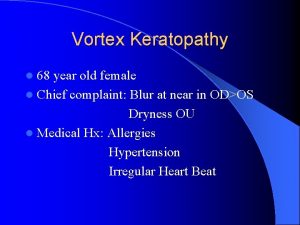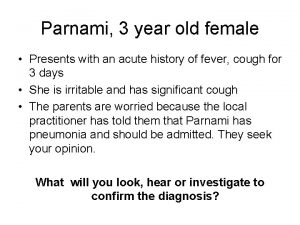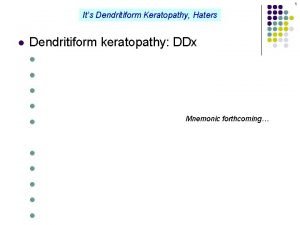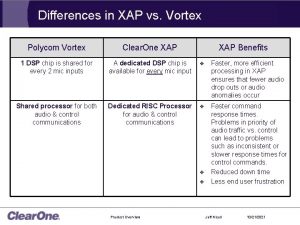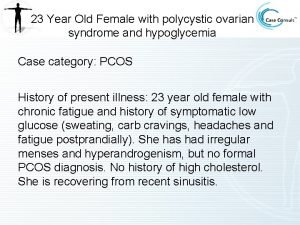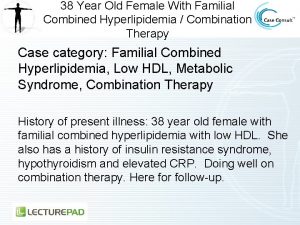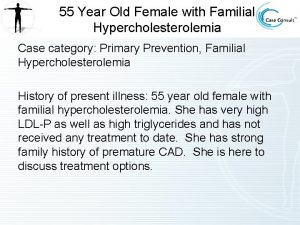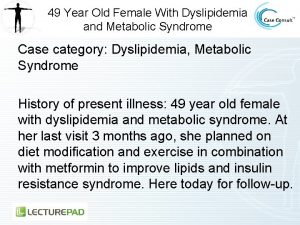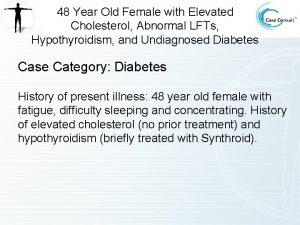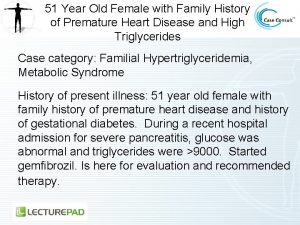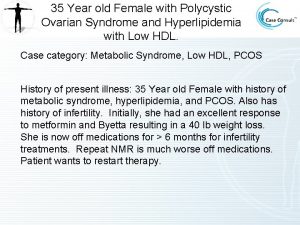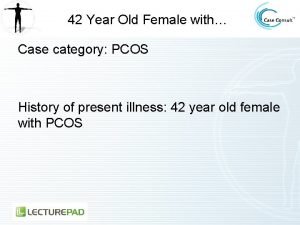Vortex Keratopathy l 68 year old female l






















- Slides: 22

Vortex Keratopathy l 68 year old female l Chief complaint: Blur at near in OD>OS Dryness OU l Medical Hx: Allergies Hypertension Irregular Heart Beat

Exam Findings l PERRL (–)APD l EOM: Full and Smooth l CF: FTFC l Rx: OD: +1. 50 -1. 00 x 085 OS: -0. 50 -1. 25 x 100 OU: +2. 25 Add l VA: 20/40 OD, 20/20 OS @ D/N

Slit Lamp Exam OD OS l Lids/Lashes: Clear l Conjunctiva: Clear l Cornea: INFERIOR WHORLS l Anterior Chamber: D&Q l Iris: Clear l IOP: 16 mm. Hg OU

Fundoscopy l Lens l C/D l A/V l Macula l Vitreous l Periphery OD OS NS 2, PSC 1+ PCIOL. 2/. 2 2/3 Clear PVD (-)Breaks/Tears

Corneal Finding

Corneal Verticillata l Whorl-like pattern of yellow or brown deposits confined to the inferior central cornea. l At the level of the deep epithelium(50 microns). l Limbal-sparing. l Delineate epithelial migration patterns.

Etiology l Fabry’s disease. l Reaction to systemic drug therapy including: Amiodarone Chloroquine Indomethacin Chlorpromazine Tamoxifen

Fabry’s Disease Fabry's disease is an X-linked recessive lipid storage disorder with an incidence of about 1 in 40, 000. l Deficiency of the enzyme alpha-galactosidase A results in the accumulation of ceramide trihexoside. l Symptoms include skin lesions and neurologic changes. Painful neuropathy is common; often associated with a low-grade fever. l Hypohydrosis is common and can lead to heatstroke. l

Fabry’s Disease Deposits of lipid in the myocardium can lead to arrhythmia, myocardial infarction and valvular dysfunction. Involvement of small cerebral vascular vessels can result in cerebral hemorrhage. l Deposits of lipid in the kidney can lead to progressive renal compromise and renal failure. l Confirmation with a blood test: Alphagalactosidase level (Normal range is 19 to 29). l

Fabrys’ Disease and the Eye l Corneal verticillata. l Conjunctival and retinal vessel tortuosity. l Oculomotor abnormalities. l Anterior subcapsular cataracts. l Periorbital edema.

Amiodarone hydrochloride is a Class III antiarrhythmic agent. l Usual dose is 200 -600 mg/ day. l Prolongs the action potential duration and refractory period of atrial, nodal and ventricular tissues. l Amiodarone increases coronary blood flow, decreases cardiac oxygen requirements and also suppresses ectopic pacemakers. l

Amiodarone and the Eye l Corneal verticillata. l Decrease in vision, rarely. l Photophobia. l Colored halos. l Dyschromatopsia. l Dry eye. l Anterior ischemic optic neuropathy*.

As it turns out… l Patient has ocular dryness, and anterior subcapsular cataract. l This patient has been on Amiodarone for several years for heart arrhythmia. l *Color vision testing may be helpful if medical history is unreliable.

Mechanism of Keratopathy l Amphiphilic drugs; amiodarone, chloroquines and phenothiazones deposit verticillata. l Verticillata form when drug complexes with phospholipids in the cells. l Complexes cannot be metabolized by lysosomal phospholipases and remain within the cornea.

Amiodarone Keratopathy l Grading System – 1 - Small, brown punctate epithelial opacities within inferior temporal cornea arranged in a single line. – 2 - Branching pattern to line of opacities. – 3 - Increase in branches to form a whorl. – 4 - Whorling with irregular clumps of brown pigment.

Amiodarone and AION l Patients on Amiodarone have a severe cerebrovascular deficit. An AION is most likely due to the illness rather than a reaction to the drug.

Studies… l Most studies suggest that all taking Amiodarone will develop verticillata. l Journal of AOA, 1985. Observations of 21 patients on a daily dosage of 200 -600 mg for periods ranging from six months to three years. Corneal deposits developed in all 21 patients and anterior lens opacities developed in 12 of 20 phakic patients.

Studies… l Cornea, 2001. Eleven patients on amiodarone therapy were observed. All patients showed the presence of high reflective, bright intracellular inclusions in the epithelial layers.

Studies… l Cardiology No. 5, 2003. Examination of 298 patients who received oral amiodarone for 1 – 122 months (mean 27, 3± 1, 5 months). l Signs of keratopathy were found in 280 patients (94%). Severity of keratopathy depended on cumulative drug dose and duration of administration.

Studies… Digital Journal of Ophthalmology, 2004. l Evaluated Amiodarone Keratopathy using the computer operated corneal topographers. l Corneal topography of 7 of 8 eyes revealed an unusual irregular astigmatism with generalized mild inferior temporal steepening consistent with the location of the corneal deposits. l Note: LASIK or PRK are not recommended. l

Topographic Scans

Treatment l There is no recommended treatment for verticillata. l Medication regimens are not altered based on the presence of corneal deposits. l If drug is stopped, most verticillata will eventually disappear within seven months. l Unknown history warrants investigation!
 Vortex keratopathy drugs
Vortex keratopathy drugs A 26 year old female presents
A 26 year old female presents Cornea guttata
Cornea guttata Bullous keratopathy
Bullous keratopathy Bullous keratopathy
Bullous keratopathy Tornado vortex signature
Tornado vortex signature Earth chakras map
Earth chakras map Atmospheric vortex engine
Atmospheric vortex engine Descartes vortex theory
Descartes vortex theory Wingtip vortex
Wingtip vortex échauffement lancer de vortex
échauffement lancer de vortex Carlo barenghi
Carlo barenghi Cast vortex solution
Cast vortex solution Toroidal vortex cannon
Toroidal vortex cannon Radomr
Radomr Barrel type continuous mixer
Barrel type continuous mixer Fenep
Fenep Karman vortex maf sensor
Karman vortex maf sensor Vortex flow in torque converter
Vortex flow in torque converter Vortex strings
Vortex strings Horse shoe vortex
Horse shoe vortex Bearistotle
Bearistotle Vortex transport
Vortex transport
